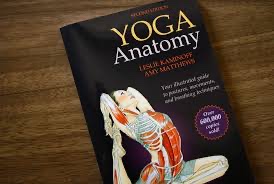
Still processing and digesting some of the always fresh and free insights of this Great Man. He has given the clearest sense of how meditation can truly be in yoga practice, or not, which seems to be more usual. He really sees through so much of the fluffy bullshit, and gets right to the sinews, in fact.
Yoga Anatomy is one of the essential texts of yoga. You find it on the bookshelf of most yoga practitioners — and certainly most teachers of yoga. Its esteemed author is Lesley Kaminoff, a student of Deshimacarya and one of the most influential figures in yoga in the West. He was back at Zen Center Regensburg recently for two days of his clear-eyed insight into the ways to find the heart of meditation — or, Zen — in yoga. I get his stuff about Ashtanga, and it’s all I need to know a little better about how to guide my practice, to develop better awareness of body and breath.
Yoga Anatomy functioned as a sort of in loco parentis teacher for me when I was doing the 90-day intensive Winter Kyol Che in Korea, and could not leave the temple for that period or interact with a qualified yoga teacher for that full three months. I was sitting at Songgwang Sah, and it was still quite early in my work with Ashtanga. Due to my loud snoring, the senior monks had given this poor barbarian his own single room, while most of the rest of the monks my dharma-age needed to sleep together in the common meditation room (the Zendo). Thanks to the Apnean Gods, I could do nearly all of the First Series in the two hours of rest-time between the conclusion of sitting at 4 p.m. and the dinner (which I never attended for the duration of retreat). Dripping with sweat, even in the depth of winter, I rushed across the freezing temple courtyard to grab a quick shower in the group shower-room, have just a few minutes for a cup of tea as the Great Bell was being struck for the whole temple’s practice to commence, and made it to my cushion for evening sitting by 7 pm. It was a rhythm I kept with almost military precision.
This practice of Ashtanga, happening in the very heart of a 90-day Zen schedule, was a blessing which gave a chance to utterly revolutionize several decades of Zen sitting. The laser-sharp samadhi of sitting was softening, even “widening,” and more was being released into realizing more constantly the presence and infinity of just-now mind. Practicing Ashtanga was instrumental, it seems, in how there has come this new blooming into constancy in depth of Moment. For years and years — since the very first 90-day Kyol Che, in 1990/91, I had always done many many prostrations during the rest periods of retreat. But this put enormous stress on the knees: Pounding out a thousand bows per day, gorging up the knees and quads with blood, and then sitting for 8-10 hours of unmoving meditation, was not a recipe for long-term health. I am convinced that the meniscus problem I suffer from today is a structural result of putting so much concentrated stress on my knees in the search for spiritual liberation.
There will be a future blog post where I will share experiences experiencing the lack of correct posture or attitude during the long retreats in the traditional Korean temples. So much drowsiness and lethargy. Guys sitting flat out of cultural pride alone, never ever using a supporting cushion under the spine, slouched and even bent at weird angles to the floor. The occasional snoring, which could go completely uncorrected for some long sittings, even weeks. Whole monk-careers slumped and never tasting the limitless vastness without border or edge or plane.
How eternally grateful I am, then, to have been able to bring Ashtanga practice into my little closet-sized room during the retreats at Songgwang Sah. Some of the Korean monks, when they would playfully do impersonations of each other during some resting-period after a hard work period effort, they almost always did imitations of various monks’ sitting postures, and the group would need to guess who it was. There would be some performance of a guy sitting in a slouch, half-bent over. “Oh, that’s so-and-so…!” Or another guy with untucked shirt and unbuttoned sitting-jacket. “Yah, that’s definitely so-and-so…!” One guy who sniffled a lot, or another who cracked his fingers from time to time during sitting. Sadly, most of the “imitations” were done of monks in various states of nodding-off, swaying unmindfully, even slumbering.
Really, I am not just saying this, but whenever a monk did an imitation of someone sitting straight upright (they sometimes dramatized the stiffness, for effect), without any movement (that was even humorous to some!), with eyes half-opened and fixed slightly forward on the floor, or with a very “correct” mudra. “Oh, that’s the American!” “That’s Hyon Gak! Ha ha ha ha ha!!”
I am grateful for having the Ashtanga technology during those retreats for the deep sittings it helped to build. I told Leslie Kaminoff that having his Yoga Anatomy was essential for helping me with keeping that daily Ashtanga practice from going into any injurious directions. It was really like having my own private yoga teacher in that little room in that crazy old traditional Korean Zen temple, in a time when I needed most to have strength and balance for handling a particularly demanding daily schedule of sitting meditation. I am so grateful that I packed that book before entering the mountains!

Share this on:
Related Posts:
-
-
During a "normal" Christmas season in the Regensburg Altstadt, the streets are teeming with people moving between the six or…
-



